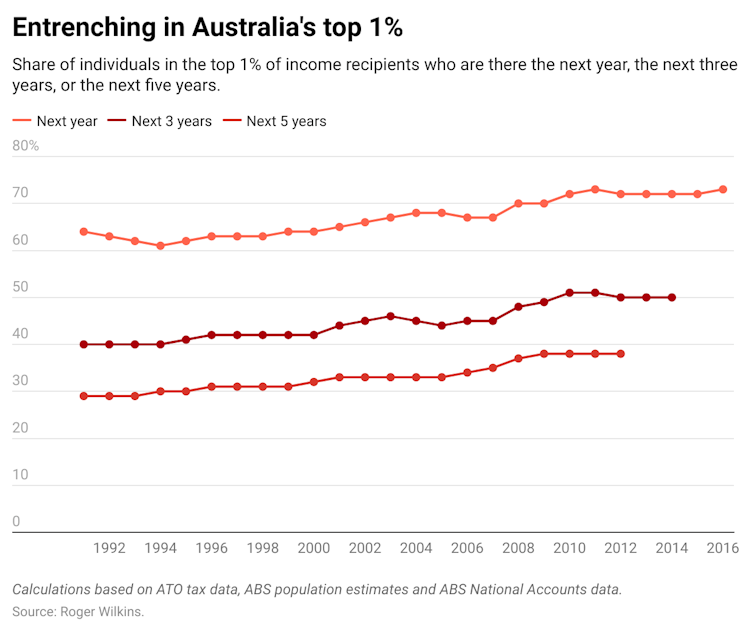The share of total income collected by the top 1 per cent of Australia’s income earners has been trending upwards since the 1980s. It is now about 9 per cent of total income.
How concerned should we be about this? To some extent it depends on fluidity of membership of the top 1 per cent (which in Australia means earning a pretax income of at least A$246,000).
If someone is part of the 1 per cent this year but not last year, this would suggest income inequality is a fact of life but at least we still have social mobility: people have good and bad years, with the top 1 per cent largely comprising people who happen to be having a good year. It won’t bother the other 99 per cent of us so much.
But if the top 1 per cent comprises the same people every year, we will be more concerned about an entrenched elite moving ever further away from the rest of us.
Top-end mobility
Our research – using newly available longitudinal tax data – has made it possible to evaluate the extent of “top-end mobility” over the past three decades. This is the first evidence on the extent to which membership of Australia’s top 1 per cent (or other top income groups) changes from year to year.
We find there is considerable mobility at the top. For example, since 1991 at least a quarter of the top 1 per cent in any given year have not been in the top 1 per cent in the next year.
But there has been an appreciable decline in top income mobility.
For example, 64 per cent of people in the top 1 per cent in 1991 were still in the top 1 per cent a year later. 73 per cent of those in the top 1 per cent in 2016 were still there in 2017.
In 1991, 29 per cent remained in the top 1 per cent for the next three years. In 2012, 38 per cent remained in the top 1 per cent for the next three years.
What our results show
Our findings, based on a variety of approaches, show most of the decrease in movements in and out of the top 1 per cent occurred in the mid-2000s and early 2010s. We found the same trend in the top 0.1 per cent and top 10 per cent income groups.
Splitting 1991 to 2015 into five periods of five years each, we find that half of those who appeared in the top 1 per cent at any time between 1991 and 1995 were there for one year only. By 2011-15 the proportion of one-time entrants had dropped to 38 per cent, meaning more people making it to the top 1 per cent staying there for longer.
Another indicator of the increased “stickiness” at the top are higher re-entry rates: those dropping out of the top 1 per cent are more likely to return in subsequent years.
They are also less likely to fall far from the top 1 per cent. In the 1990s the income of about 35 per cent of those falling out of the top 1 per cent declined far enough for them to no longer being in the top 5 per cent. That is now happening to only about 20 per cent.
Diminishing opportunities to join the 1 per cent
Interestingly, we find no evidence that lower mobility in and out of the top 1 per cent is due to the 1 per cent increasing its share of total income.
The periods that saw mobility reduced – the mid-2000s and early 2010s – do not correspond to periods of rising top income shares. In other words, this is not a story about the rungs of the income ladder growing further apart and making climbing the ladder more difficult.
But it is a story of diminishing opportunities to have a top income.
While national differences are difficult to assess because of comparability issues, Australi’s lack of mobility among its top 1 per cent appears to be more pronounced than that found in other countries. For example, the US appears to show considerably more mobility.
An in-depth account of why top incomes are increasingly stable is a story yet to be told. But it is hard to escape the conclusion that Australia has experienced declining economic dynamism, where the rich are increasingly dominated by old money, and where we have fewer entrepreneurs breaking into the income elite.
The authors wish to acknowledge the contribution of Dean Hyslop, senior fellow with Motu Economic and Public Policy Research in New Zealand, to this research.![]()
![]()
Roger Wilkins, Professorial Fellow and Deputy Director (Research), HILDA Survey, Melbourne Institute of Applied Economic and Social Research, The University of Melbourne; Nicolas Herault, Academic, Melbourne Institute of Applied Economic and Social Research, The University of Melbourne, and Stephen P. Jenkins, Professor of Economic and Social Policy, London School of Economics and Political Science. This article is republished from The Conversation under a Creative Commons license. Read the original article.





























Trending